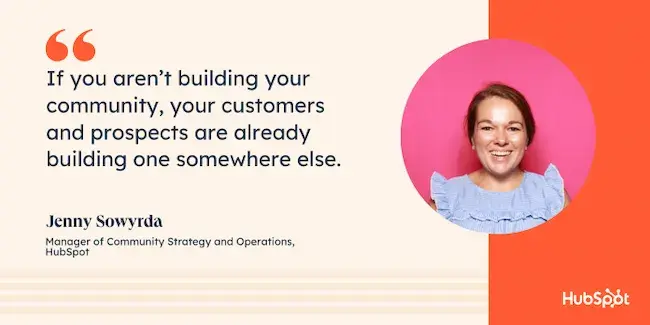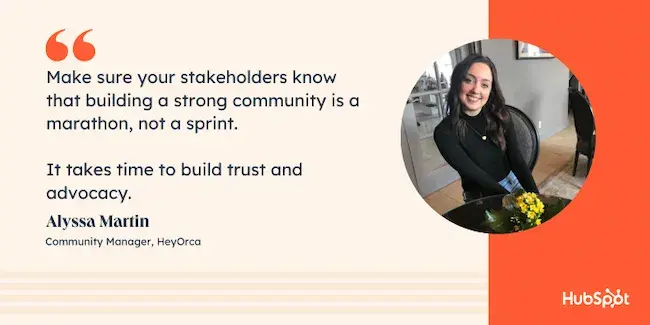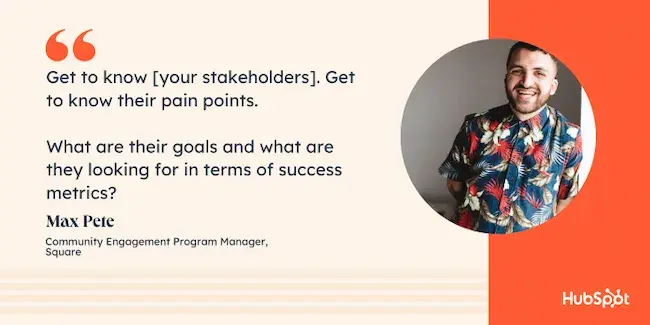In a perfect world, my car would run on starlight and dreams, fries would taste good reheated, and we would never be asked to prove the ROI of community management.
Unfortunately, that’s not the world we live in — so I reached out to 3 different community management experts and asked how they show the value of their community.
Below, I’ll share their best tips for communicating ROI to your stakeholders. (We’ll tackle the fries thing another day.)
But first, it helps to know what you’re up against…
Table of Contents
- Why is it so stinkin’ hard to show the value of community management?
- Tips for Proving the ROI of Community Management
- Drawing a Line from KPI to ROI
Why is it so stinkin’ hard to show the value of community management?
If you run a community (or have been a part of one) the value is self-evident. So why isn’t it as easily stakeholder-evident, too?
As you take on reporting for your community, you need to keep these challenges in mind.
The benefits aren’t always monetary.
Direct access to your customers is priceless. Unfortunately, that means it’s also hard to put a price tag on it.
And how do you measure the value of a user who didn’t file a support ticket because they found the answer in your community?
The benefits aren’t always visible.
Brand awareness, advocacy, sales acceleration, and increased product usage are all very real, very tangible benefits of a thriving community.
Unfortunately, unless a member comes right out and says it’s because of your community, those benefits are usually happening behind the scenes.
Tracking attribution is tricky.
Even when the benefits are both visible and monetary (like leads, signups, or sales) it can be difficult to show that your community was the interaction that caused that conversion.
It’s likely that your members go through several touchpoints (blogs, videos, events, etc.) before even reaching a potential conversion event.
It often spans multiple channels.
Finally, as your community grows, it will likely live on some combination of forums, Slack, social media, etc.
That’s great for growth, but a challenge for analytics.
But hope isn’t lost. Behind every successful community is a leader who figured out how to report on its value. Below, you’ll hear from three experts who’ve done exactly that.
Tips for Proving the ROI of Community Management
Ultimately, the only way to show ROI is to draw a straight line from your community’s actions to the stakeholder’s goals.
Of course, we know from the challenges above that it’s not always that simple in the living. Here are some actionable ways to make that happen.
1. Get buy-in before you build.
Showing a return on investment is a lot easier when your stakeholders understand what the potential value is. Without buy-in, you’re not actually reporting on progress toward that value; you’re trying to justify your existence.
“In theory, if your company is launching a community you already have executive buy-in,” says Jenny Sowyrda, HubSpot’s very own manager of community strategy and operations.
“If you don’t, pause here and go back to find an ally who wants you to have a community,” she adds.
(Seriously. Stop reading and go book a meeting.)

“A very blunt way to say this is that if you aren’t building your community, your customers and prospects are already building one somewhere else,” Sowyrda says.
“And when you don’t manage the community where your brand is being discussed, you lose control of the narrative, you lose direct access to your audience, and you’re going to be running an uphill battle of trying to build trust with a group of people who don’t need you.”
But how do you get that buy-in if you don’t have anything to report on yet? Jenny has your back in our next tip.
2. Start with a small pilot.
“I would call out the importance of experimenting and testing before going all in on a community effort,” says Sowyrda. “Start small and simple and then scale.”
In other words, start with a small pilot that can serve as a proof-of-concept for larger community efforts. That may look like a simple Facebook group, a product forum, or a single, dedicated channel on Discord or Slack.
“This gives you time to identify what your success metrics are, see if there is a positive correlation, and then scale,” she adds.
If you find that positive correlation, you’ve now got the data you need to make your case to leadership. And if you don’t find the correlation, your program is still light enough to try something new.
3. Set clear expectations for timeline.
You’ve presented your pilot and gotten buy-in; the next most important thing to talk about is timeline.
“There are no quick wins in community,” cautions Jenny Sowyrda. “Yet it is such an important part of building a trustworthy and valuable company.”
That may not be immediately clear to business leaders who are used to the relatively fast turnaround of paid ads and traditional marketing. It’s part of your job to set expectations for the timeline — and you need to set them early and repeatedly.
“Make sure your stakeholders know that building a strong community is a marathon, not a sprint,” says Alyssa Martin, community manager at HeyOrca. “It takes time to build trust and advocacy.”

4. Ask stakeholders about their goals and what metrics define success.
While you’re having those initial conversations anyway, go ahead and ask your stakeholders what they care about.
“Get to know them, get to know their pain points,” says Max Pete, community engagement program manager at Square. “What are their goals and what are they looking for in terms of success metrics?”
Another great question is how they define “success”—both in terms of data and outcome. Other questions to consider are:
- What metrics do you use to measure your goals?
- What would a meaningful impact look like to those goals?
- What outcomes do you need to see from this project?
“It is super important to have those early conversations with key stakeholders on what is important data for them,” Max adds. “[Proving ROI is] difficult if you don’t know what you should be reporting on.”
5. Approach reporting as problem solving.
One of my absolute favorite takeaways from talking with Max Pete: To approach reporting not as simply presenting data — but as how community helps to solve stakeholder problems.
Now that you know their goals, pain points, and definitions of success, tailor your reporting to tell a story about how the community addresses all of that.
As a bonus, this mindset will also help you focus your reporting on only the most important community management metrics.

6. Connect your community to other teams.
Finally, consider that stakeholder goals aren’t the only way to show value. By connecting your efforts to other team’s goals, your community increases its own ROI.
“I am very biased but I’m pretty sure you can apply community to every element of your business,” Jenny says with a smile.
Max Pete gives the example of using Square’s community reach to bring attention to a new marketing campaign.
“Because our cross-functional partner and I had a common goal of increasing engagement, we came up with a month-long activation campaign for members to participate in the community,” Pete says. “The idea was to drive conversation around specific topics and use a CTA to drive members to read more.”
In the end, the collaboration boosted traffic to the marketing campaign while also increasing engagement among the community—a win-win for both teams!
And both of those successes will look great during stakeholder meetings.
Drawing a Line from KPI to ROI
So now you’ve established goals. You’ve set expectations. You’ve defined success. It’s time to choose what metrics will combine all of that into a cohesive story.
We’ll go deeper into how to measure these KPIs in our blog about community management metrics, but for now, here are some options to consider based on what your stakeholders value.
Brand Awareness
Social Mentions
“This is probably one of my favourite ways to prove how a community is building trust,” says HeyOrca’s Alyssa Martin. “Always take screenshots of these posts! It’s great to have to help prove your point.”
Share of Voice
Share of voice compares your portion of brand awareness against competitors. In addition to social mentions, it can include paid ads clicks or keyword traffic.
Referral Rate/Advocacy Rate
If your stakeholders are focused on brand awareness, referral rate is a great metric to highlight. Communities are uniquely effective in turning customers into promoters.
Event Participation Rate
This can refer to in-person events as well as online events like courses or webinars. Community members often have a higher participation rate than non-member audiences.
Conversion/Revenue
Conversion Rate (CVR)
This can be a tricky metric, because communities made up of existing customers may have a lower conversion rate. You’ll have to define what conversion means for those cases.
Community Attributed Leads/Signups/Sales
This is another area where cross-functional campaigns can help. Other teams may already have access to downstream reporting on their own success metrics. If you can show that your community is a source of traffic for those teams, that can help you connect their conversions to your community campaigns.
Cost Per Conversion (CPC)
You’ll need to calculate the total cost of running your community in order to find your CPC. That can be a big ask, but it’s likely worth the effort.
You’ll probably find that community-attributed conversions are much more cost-effective than other forms of marketing.
Customer Service/Customer Support
Traffic to FAQ Pages or Knowledge Base Articles
Remember above when we asked how to show the value of a customer who doesn’t file a support ticket? This is one way.
If you can show that your community is a major source of traffic to self-service resources, it indicates that your community is saving your company money.
Average Response Time
Since you’re spending so much time with your community, you may find that your response time is quicker than officially filed tickets.
Response Rate
While this typically refers to the number of queries that receive a response, Jenny Sowyrda explains that it can also refer to the percentage of responses that come from your company (versus other members).
That can be a good indicator that your members are receiving accurate information from trustworthy sources.
Resolution Rate
This metric is like response rate, but specific to members who bring up issues or complaints.
Product or Company Feedback
Surveys and Polls
Direct access to customer/prospect opinions is one of the unique benefits of community management, and you should be tapping into it often.
“If you want to know what they want, you can just ask them!” says Sowyrda. “If you want to know what they don’t like, they’re probably already telling you (but you can also just ask them!)”
Net Promoter Score (NPS)
You may not know it by name, but you’ve definitely encountered NPS surveys before.
NPS is based on some variation of the question “On a scale of 0-10, how likely are you to recommend our brand/product/service to a friend or colleague?”
Sentiment Analysis
Sentiment analysis refers to using software to analyze the emotional tone of content. A good community management tool can help you analyze how your members feel about your company, product, or service.
Feature Requests
Your members can be one of the best sources of new ideas for improving your products and services.
And, in return, fulfilling feature requests can be one of the best ways to delight your community members.
Product Feedback
“You can give the microphone to your community and let them speak about their experience and expertise,” says Jenny.
If you follow the tips from our experts, you should be able to quickly narrow down which of these metrics are right for your community.
Soon, you’ll be the expert who’s figured out how to prove the ROI of community management. Next stop, french fries.
![]()

![Download Now: 3 Community Management Templates [Free Kit]](https://i4lead.com/wp-content/uploads/2024/07/866a5201-b39e-4edb-9e7f-65c0d98a9ea0-13.png)

![Download Now: 3 Community Management Templates [Free Kit]](https://i4lead.com/wp-content/uploads/2024/07/866a5201-b39e-4edb-9e7f-65c0d98a9ea0-12.png)

![Download Now: 3 Community Management Templates [Free Kit]](https://i4lead.com/wp-content/uploads/2024/07/866a5201-b39e-4edb-9e7f-65c0d98a9ea0-11.png)








![Download Now: 3 Community Management Templates [Free Kit]](https://i4lead.com/wp-content/uploads/2024/07/866a5201-b39e-4edb-9e7f-65c0d98a9ea0-10.png)

![Download Now: 3 Community Management Templates [Free Kit]](https://i4lead.com/wp-content/uploads/2024/07/866a5201-b39e-4edb-9e7f-65c0d98a9ea0-9.png)






![Download Now: 3 Community Management Templates [Free Kit]](https://i4lead.com/wp-content/uploads/2024/07/866a5201-b39e-4edb-9e7f-65c0d98a9ea0-8.png)








![Download Now: 3 Community Management Templates [Free Kit]](https://i4lead.com/wp-content/uploads/2024/07/866a5201-b39e-4edb-9e7f-65c0d98a9ea0-7.png)




![Download Now: 3 Community Management Templates [Free Kit]](https://i4lead.com/wp-content/uploads/2024/07/866a5201-b39e-4edb-9e7f-65c0d98a9ea0-6.png)




![Download Now: 3 Community Management Templates [Free Kit]](https://i4lead.com/wp-content/uploads/2024/07/866a5201-b39e-4edb-9e7f-65c0d98a9ea0-5.png)












![Download Now: 3 Community Management Templates [Free Kit]](https://i4lead.com/wp-content/uploads/2024/07/866a5201-b39e-4edb-9e7f-65c0d98a9ea0-4.png)


